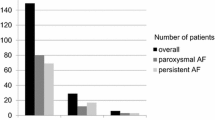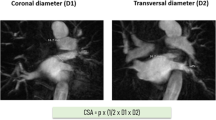Abstract
Purpose
Symptomatic severe pulmonary vein stenosis (PVS) after catheter ablation of atrial fibrillation (AF) is a rare but well-recognized complication. Treatment options include pulmonary vein angioplasty with or without drug eluting balloons or angioplasty with stent implantation. The treatment of choice is unclear. In our center, pulmonary vein stenting is the treatment of choice for significantly stenotic veins. We present the long-term clinical outcome of 9 patients treated with stent implantation.
Methods
Between 2001 and 2015, 3048 patients with AF were treated with catheter ablation at our institution, of which 9 developed symptomatic PVS. A total of 11 PVS were treated. Pre-procedural imaging (CT, MR, transesophageal echocardiography, angiography) was performed in all patients.
Results
Mean time from ablation to stenting was 18 months. Three patients had recurrent pneumonia and the remaining reduced functional capacity (NYHA 2). All patients were in functional capacity NYHA 1 (p < 0.05) after a mean follow-up of 64 (18–132) months. Three patients still had paroxysmal AF, of which two have undergone repeated ablation.
Conclusions
Symptomatic PVS after AF ablation can be successfully treated by stent implantation with durable results and good clinical outcome. AF ablation is still a feasible option after stent deployment.

Similar content being viewed by others
Abbreviations
- AF:
-
Atrial fibrillation
- RFA:
-
Radiofrequency catheter ablation
- PV:
-
Pulmonary vein
- PVS:
-
Pulmonary vein stenosis
- NYHA:
-
New York Heart Association Functional Classification
- TEE:
-
Transesophageal echocardiography
- TSP:
-
Transseptal puncture
References
Ball J, Carrington MJ, McMurray JJ, Stewart S. Atrial fibrillation: profile and burden of an evolving epidemic in the 21st century. Int J Cardiol. 2013;167(5):1807–24. https://doi.org/10.1016/j.ijcard.2012.12.093.
Chugh SS, Havmoeller R, Narayanan K, Singh D, Rienstra M, Benjamin EJ, et al. Worldwide epidemiology of atrial fibrillation: a Global Burden of Disease 2010 Study. Circulation. 2014;129(8):837–47. https://doi.org/10.1161/CIRCULATIONAHA.113.005119.
Zoni-Berisso M, Lercari F, Carazza T, Domenicucci S. Epidemiology of atrial fibrillation: European perspective. Clin Epidemiol. 2014;6:213–20. https://doi.org/10.2147/CLEP.S47385.
Ganesan AN, Shipp NJ, Brooks AG, Kuklik P, Lau DH, Lim HS, et al. Long-term outcomes of catheter ablation of atrial fibrillation: a systematic review and meta-analysis. J Am Heart Assoc. 2013;2(2):e004549. https://doi.org/10.1161/JAHA.112.004549.
Calkins H, Brugada J, Packer DL, Cappato R, Chen SA, Crijns HJ, et al. HRS/EHRA/ECAS expert consensus statement on catheter and surgical ablation of atrial fibrillation: recommendations for personnel, policy, procedures and follow-up. A report of the Heart Rhythm Society (HRS) Task Force on Catheter and Surgical Ablation of Atrial Fibrillation developed in partnership with the European Heart Rhythm Association (EHRA) and the European Cardiac Arrhythmia Society (ECAS); in collaboration with the American College of Cardiology (ACC), American Heart Association (AHA), and the Society of Thoracic Surgeons (STS). Endorsed and approved by the governing bodies of the American College of Cardiology, the American Heart Association, the European Cardiac Arrhythmia Society, the European Heart Rhythm Association, the Society of Thoracic Surgeons, and the Heart Rhythm Society. Europace. 2007;9(6):335–79. https://doi.org/10.1093/europace/eum120.
Rostamian A, Narayan SM, Thomson L, Fishbein M, Siegel RJ. The incidence, diagnosis, and management of pulmonary vein stenosis as a complication of atrial fibrillation ablation. J Interv Card Electrophysiol. 2014;40(1):63–74. https://doi.org/10.1007/s10840-014-9885-z.
Calkins H, Kuck KH, Cappato R, Brugada J, Camm AJ, Chen SA, et al. 2012 HRS/EHRA/ECAS expert consensus statement on catheter and surgical ablation of atrial fibrillation: recommendations for patient selection, procedural techniques, patient management and follow-up, definitions, endpoints, and research trial design: a report of the Heart Rhythm Society (HRS) Task Force on Catheter and Surgical Ablation of Atrial Fibrillation. Developed in partnership with the European Heart Rhythm Association (EHRA), a registered branch of the European Society of Cardiology (ESC) and the European Cardiac Arrhythmia Society (ECAS); and in collaboration with the American College of Cardiology (ACC), American Heart Association (AHA), the Asia Pacific Heart Rhythm Society (APHRS), and the Society of Thoracic Surgeons (STS). Endorsed by the governing bodies of the American College of Cardiology Foundation, the American Heart Association, the European Cardiac Arrhythmia Society, the European Heart Rhythm Association, the Society of Thoracic Surgeons, the Asia Pacific Heart Rhythm Society, and the Heart Rhythm Society. Heart Rhythm. 2012;9(4):632–96 e21. https://doi.org/10.1016/j.hrthm.2011.12.016.
Di Biase L, Fahmy TS, Wazni OM, Bai R, Patel D, Lakkireddy D, et al. Pulmonary vein total occlusion following catheter ablation for atrial fibrillation: clinical implications after long-term follow-up. J Am Coll Cardiol. 2006;48(12):2493–9. https://doi.org/10.1016/j.jacc.2006.08.038.
Saad EB, Marrouche NF, Saad CP, Ha E, Bash D, White RD, et al. Pulmonary vein stenosis after catheter ablation of atrial fibrillation: emergence of a new clinical syndrome. Ann Intern Med. 2003;138(8):634–8.
Latson LA, Prieto LR. Congenital and acquired pulmonary vein stenosis. Circulation. 2007;115(1):103–8. https://doi.org/10.1161/CIRCULATIONAHA.106.646166.
Kumar N, Aksoy I, Pison L, Timmermans C, Maessen J, Crijns H. Management of pulmonary vein stenosis following catheter ablation of atrial fibrillation. J Atr Fibrillation. 2014;7(1):1060. https://doi.org/10.4022/jafib.1060.
Neumann T, Kuniss M, Conradi G, Sperzel J, Berkowitsch A, Zaltsberg S, et al. Pulmonary vein stenting for the treatment of acquired severe pulmonary vein stenosis after pulmonary vein isolation: clinical implications after long-term follow-up of 4 years. J Cardiovasc Electrophysiol. 2009;20(3):251–7. https://doi.org/10.1111/j.1540-8167.2008.01316.x.
Prieto LR, Schoenhagen P, Arruda MJ, Natale A, Worley SE. Comparison of stent versus balloon angioplasty for pulmonary vein stenosis complicating pulmonary vein isolation. J Cardiovasc Electrophysiol. 2008;19(7):673–8. https://doi.org/10.1111/j.1540-8167.2008.01110.x.
Fink T, Schluter M, Heeger CH, Lemes C, Lin T, Maurer T, et al. Pulmonary vein stenosis or occlusion after catheter ablation of atrial fibrillation: long-term comparison of drug-eluting versus large bare metal stents. Europace. 2017; https://doi.org/10.1093/europace/eux291.
Author information
Authors and Affiliations
Corresponding author
Ethics declarations
Conflict of interest
The authors declare that they have no conflict of interest.
Ethical approval
All procedures performed in studies involving human participants were in accordance with the ethical standards of the institutional and the national research committee.
Informed consent
Informed consent was obtained from all individual participants included in the study.
Rights and permissions
About this article
Cite this article
Iversen, E., Packer, E.J.S., Sandberg, S.M. et al. Long-term follow-up in patients treated by stent implantation for post-ablation pulmonary vein stenosis. J Interv Card Electrophysiol 53, 309–315 (2018). https://doi.org/10.1007/s10840-018-0370-y
Received:
Accepted:
Published:
Issue Date:
DOI: https://doi.org/10.1007/s10840-018-0370-y




